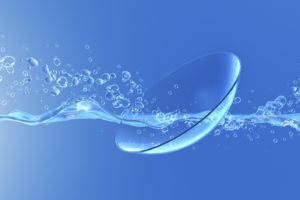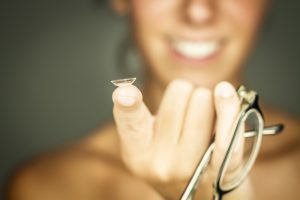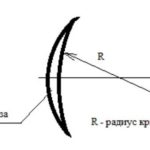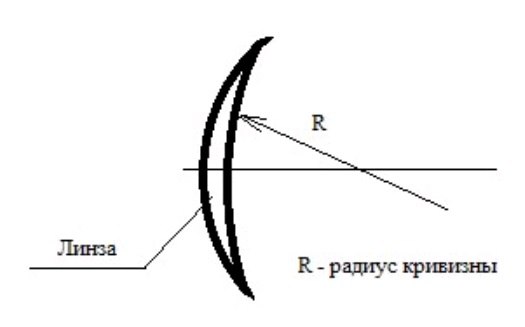Contact lens material
 Vision correction using contact lenses is a non-surgical method and allows you to correct astigmatism, myopia and hypermetropia.
Vision correction using contact lenses is a non-surgical method and allows you to correct astigmatism, myopia and hypermetropia.
The lenses are smaller, making them more comfortable to wear and offering several benefits, such as being smaller and providing peripheral vision.
Today, all products on the market are divided into into two large groups: hard and soft. A number of properties and characteristics differ from each other depending on the materials from which they are made.
The content of the article
Composition of hard lenses
 Rigid ones can be made from gas-permeable and gas-tight materials.
Rigid ones can be made from gas-permeable and gas-tight materials.
Material for gas permeable lenses
The main material for their production is silicone, which has excellent breathability. They ensure maximum supply of oxygen and other important nutrients to the surface of the cornea of the eyes.
Important! Be prepared for tearing, redness, and other symptoms that may last from several hours to several days.
The difference between gas-permeable ones is their lower water content, but this allows them to maintain the necessary shape and rigidity.
Material for gas-tight lenses
 The main material for manufacturing is organic glass or polymethyl methacryolate. However, it does not allow oxygen to pass through in the required quantity. Therefore, more modern ones are made of silicone, which is more convenient compared to polymethyl methacryolate (PMMA). Due to this PMMA is no longer prescribed by doctors today.
The main material for manufacturing is organic glass or polymethyl methacryolate. However, it does not allow oxygen to pass through in the required quantity. Therefore, more modern ones are made of silicone, which is more convenient compared to polymethyl methacryolate (PMMA). Due to this PMMA is no longer prescribed by doctors today.
Water content of hard contact lenses
 The water content of the composition is determined by determining the ratio of the weight of the entire lens and the weight of the water itself as a percentage. This indicator is designated as Dk. The higher the water content in the composition, the higher their sensitivity to various mechanical influences. Also, those products that have a large Dk contribute dry eyes, since during wear the liquid gradually dries out, and the optical parameters change accordingly.
The water content of the composition is determined by determining the ratio of the weight of the entire lens and the weight of the water itself as a percentage. This indicator is designated as Dk. The higher the water content in the composition, the higher their sensitivity to various mechanical influences. Also, those products that have a large Dk contribute dry eyes, since during wear the liquid gradually dries out, and the optical parameters change accordingly.
Composition of soft lenses
Soft ones can be made of hydrogel and silicone hydrogel, both of which use hydrogel.
Material for silicone hydrogel lenses
 The main materials for production are silicone and hydrogel. Silicone is hydrophobic, which means it already contains water.
The main materials for production are silicone and hydrogel. Silicone is hydrophobic, which means it already contains water.
pros:
- high level of breathability and the possibility of prolonged wear, that is, without taking it off at night and feeling a lack of oxygen.
On to the cons applies:
- individual intolerance, some patients cannot use them;
- presence of a period for adaptation;
- relatively high cost.
Hydrogel lens material
For the first time, hydrogel material became known in the sixties of the last century.
Pros:
- The main quality of these materials is hydrophilicity, that is, they attract water. They perfectly transport oxygen to the cornea of the eye, since they consist of more than 35% water;
- The advantages include easy selection and lack of addiction, as well as a relatively low price.
Minuses:
- Disadvantages include the ability to be worn only during the day and low gas permeability.
Water content in soft lenses
Based on water content, they are divided into three types:
- with high moisture content - more than 60%;
- with an average moisture content of about 50–60%;
- with low moisture content - less than 40%.
Important! The higher the percentage of water content, the more comfortable the products are to wear, and therefore, the more comfortable they are to wear.
What material to choose contact lenses from?
 There is no definite answer to this question. It all depends on the individual characteristics of the body, tolerance, disease, and so on. Therefore, in order to choose the right products that will provide the maximum level of comfort for you, you need to contact a specialist and consult him.
There is no definite answer to this question. It all depends on the individual characteristics of the body, tolerance, disease, and so on. Therefore, in order to choose the right products that will provide the maximum level of comfort for you, you need to contact a specialist and consult him.
Most often today, experts prescribe silicone hydrogel lenses., since they combine a sufficient level of moisture content, breathability, the necessary elasticity, comfortable wearing and excellent optical performance. However, it is important to take into account the consumer’s personal preferences, wishes, and tolerance.





